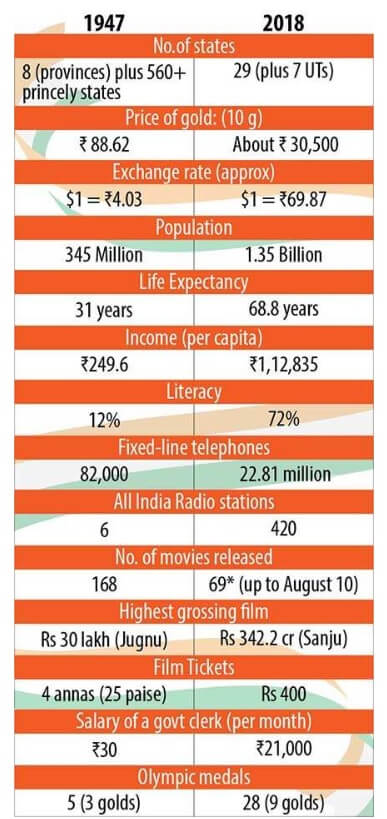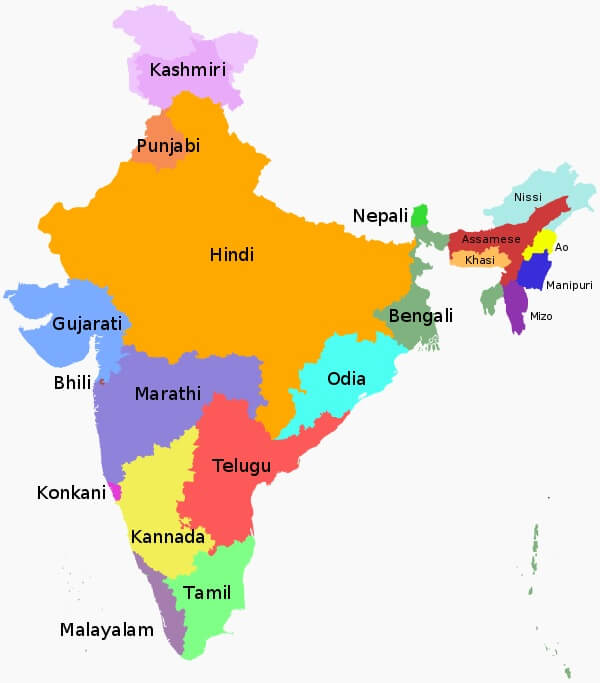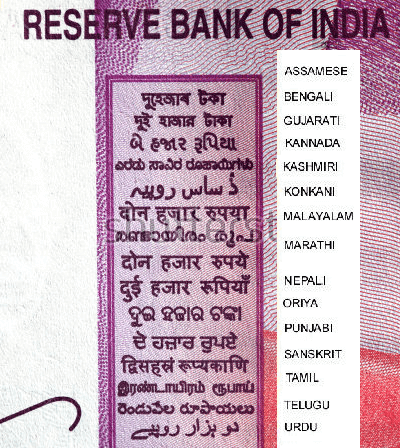Our constitution describes ‘India that is Bharat’ is a union of states. And it is a sovereign, secular, socialist and democratic republic. India is la and of diversity and myriad forms of people of different races, culture and religions live in India making India a nation of contradictions. Let’s compare India in 1947 vs 2018. See what are predictions for India at 100 ie in 2047. Understand why India is Growing, What world thinks of India. Why we have No National Language, North-South Divide, Bharat vs India Divide
According to author Mark Twain: “India is the cradle of the human race, the birthplace of human speech, the mother of history, the grandmother of legend, and the great-grandmother of tradition. Our most valuable and most instructive materials in the history of man are treasured up in India only.”
Table of Contents
Comparing India in 1947 vs Now
The occasion of Independence Day, Republic Day always allows for a rewind and gives us an occasion to evaluate how far we have come. So many years and huge changes later, we zoom in on a few key indicators for India: Ref Times of India 15 Aug 2018
- Food Production: From receiving food aid in the 1950s and 1960s to becoming a net exporter, India has seen a turnaround in food production. The total food production, which stood at 54.92 million tonnes in 1950, rose to 305.44 million tonnes in 2020-21.
- Gross Domestic Product (GDP): India’s GDP was ₹ 2.7 lakh crore at Independence. It has reached ₹ 135.13 lakh crore. India is now the 6th largest economy in the world and is on its way to becoming the third-largest by 2031, as per Bank of America
- Indian Rupee US dollar was equal to ₹ 3.30 in 1947. Notably, India’s rupee was pegged to the UK Pound Sterling, not the US Dollar. In August 2021, US $1 is equal to ₹ 74.
- Forex: India’s forex reserves (In foreign currencies and other assets like gold) stood at a meagre ₹ 1,029 crore in 1950-51. In fact, India’s low forex reserves played the catalytical role in kickstarting the economic reforms. With just $1.2 billion worth of forex reserves in 1991, India just had enough reserves to finance 3 weeks of imports. Three decades since the reform process began, India’s forex reserves now stand at ₹ 46.17 lakh crore – the world’s fifth-largest.
- Access to electricity (rural areas): According to the Ministry of Power, only 3,061 villages had access to electricity in 1950. In 2018, the Indian government announced that all of India’s villages – 5,97,464 in total – had been electrified.
- Roadways (length): Roads have expanded exponentially in the last 75 years. In 1950, as per government figures, India only had 0.4 million kilometres of roadways, which has grown to 6.4 million kilometres in 2021.

Compare India in 1947 with 2018
What will be India like in 2047

How India will be in 2047
Video on Why is India Growing so fast
India is poised to be the world’s fastest-growing major economy this year. CNBC’s Xin En Lee explains what the world’s second most populous economy has going for it.
What world thinks of India
India a nation of Contradictions
Our constitution describes ‘India that is Bharat’ is a union of states. And it is a sovereign, secular, socialist and a democratic republic. India is la and of diversity and myriad forms of people of different races, culture and religions live in India making India a nation of contradictions.
India vs Bharat
Our country is developing as two distinctly different states India and Bharat.
About two-thirds of Indians today are still farmers. They live in villages that consist of a handful of tiny mud huts, each containing a sleeping room, a second room for the kitchen and an outdoor latrine. The muddy paths between the huts are littered with cow dung. More than 300 million Indians live in poverty and 400 million are illiterate. India is home to 44% of the world’s poor.
Horse-drawn carts dodge trucks as they drive the wrong way down the national highway, overloaded with leaking sacks of grain. Visibly weak infant children break stones in the central reservation, helping to repair the road surface. The images most foreigners have of India are of vast slums, poverty-stricken villages, unkempt roads, snake charmer etc.
The major metropolises are home to 400 million Indians, from actors in the Indian film industry, software engineers and steel magnates. And India is also home to some of the world’s richest billionaires; Mukesh Ambani, Azim Premji and Kush Pal Singh, to name a few. From the 1990s few years, India has seen a revolution in the IT sector. Infosys Technologies, Reliance, Tata Motors, and Wipro have all made the leap from mere domestic companies to internationally renowned brands
India Bharat The Names
Our constitution describes ‘India that is Bharat’ is a union of states.
Jambudvipa : The scriptures say “jambu dweepe Bhaarata varshe.” The word Jambudvīpa literally refers to “the land of Jambu trees” where jambu is the name of the species (also called Jambul or Indian Blackberry) and dvīpa means “island” or “continent”.
Bharata, the official name of India in Hindi, is the abbreviated form Bharatvarsha. The term “Bharatvarsha” is first cited in Vishnu Purana as the country (varṣam) that lies north of the ocean and south of the snowy mountains is called Bhāratam; there dwell the descendants of Bharata. Here, Bharata is referred to the mythical Vedic age King of Bharata and Varsha means the country.
Hindustan: The invaders of Bharat came up to the river Sindhu. According to many historians and linguistics, Persians were not able to pronounce Sindh properly. They replace “S” sound with “H” sound in their language. Thus, the word became Sindh to Hind. The Hindustan means the land of Hind.
India: The English term is from Greek Ἰνδία (Hindia), via Latin transliteration India. Greek did not have a separate letter for the H sound in 500 BCE and used a sign of aspiration above the first vowel, which was eventually lost in Latin transliteration.
The name India was known in Old English language and was used in King Alfred’s translation of Paulus Orosius. In Middle English, the name was, under French influence, replaced by Ynde or Inde, which entered Early Modern English as Indie. The name India then came back to English usage from the 17th century onwards and may be due to the influence of Latin, or Spanish or Portuguese.
When we speak in our regional languages we use the name Bharat or Bharata Matha. But while addressing the nation in English, we refer to it as India
National Language of India
India does not have a national language. However, Hindi and English are used for official purposes of the Union and for use in Parliament. There are 22 official languages as mentioned in article 343/1 of the Constitution of India. The states of India are free to adopt one or more local languages for all or any of the official purposes of that state. However Hindi continues to be the predominant language of the Central government.
22 Offical languages of India
India has 22 official languages, namely Assamese, Bengali, Bodo, Dogri, Gujarati, Hindi, Kannada, Kashmiri, Konkani, Maithili, Malayalam, Manipuri, Marathi, Nepali, Oriya, Punjabi, Sanskrit, Santhali, Sindhi, Tamil, Telugu and Urdu.

22 Official languages in India
Languages on the Currency notes
Currency notes in India typically carry the denomination in all 17 languages. 15 languages on reverse of Indian Notes and 2, Hindi and English, on the front of the note.

Languages on Indian Notes
Why doesn’t India have a national Language?
After independence, constitution makers had a problem of selecting a national language which can unite a country because there were more than 1600 languages spoken in different parts of the country.
At that time Hindi was an option as Hindi was being spoken by 40% of Indians at that time. But what about non-Hindi speaking states and other documents and books which were inherited by Britishers which were written in English during British Raj. So at that time, under Artcile 343 it was decided that along with Hindi, English will also be an official language. But English will be the official language only for the next 15 years i.e. till 1965
In late 1964, an attempt was made for an end to the use of English, but it was met with protests from states such as Maharashtra, Tamil Nadu, Punjab, West Bengal, Karnataka, Puducherry and Andhra Pradesh. “Hindi is as much foreign to non-Hindi speaking people as English is to the protagonists of Hindi”. Some of these protests also turned violent. As a result, the proposal was dropped. So government at that time said that states can choose Hindi, English or the language spoken in their states for all official purposes. (8th Schedule)
So now there are 22 languages as the official language of India and no National Language.
This was all done under 8th schedule in which till now 22 languages are official languages and there is a demand of adding 38 more languages under 8th schedule.
North South Divide
India also suffers from the North-South divide characterized by differences in geography, economy, politics etc. Beyond the more familiar Bharat/India divide, it is the north/south divide that may prove consequential.
Post-1990 reforms, there was an increase in inter-state inequality. States like Tamil Nadu, Karnataka, Andhra Pradesh made use of the opportunities provided by reforms to develop, states like Bihar, UP, Rajasthan, Madhya Pradesh, Jharkhand, Chattisgarh left behind.
- India is slowly cleaving into two countries – a richer, older South and a poorer, younger North.According to Census 2011, southern states are showing a faster decline in the population growth rate as compared to the northern states. As a result of this, there is a scarcity of unskilled labour in the south which is currently filled in by migration from other parts of the country. This was also pointed out by Economic Survey 2015-16. Changing demographic patterns and migration of unskilled labourers from North to South has the potential to generate a cultural conflict in the country. For peninsular states, demographic dividend will peak in 2020. Whereas in Northern states it will peak in 2040.
North-South India is generally represented by states to north and south of Vindhyas.
North India The Hindi-belt of Uttar Pradesh, Madya Pradesh, Bihar, Jharkhand, Chattisgarh, Rajasthan, Delhi, Punjab, Haryana is generally considered as the heartland of North India.
South India Tamil Nadu, Andhra Pradesh, Telangana, Karnataka, Kerala is considered mainly as South India. Many people call South Indians by a general term Madrasi which means from Madras. But a person/culture from Kerala is very different from that of Tamil Naidu or Andhra Pradesh or Karnataka.
People North vs South India
Belonging to different racial races, North Indians and South Indians carry different personalities. North Indians are generally taller, fairer and heavily built whereas South Indians are slightly dark in complexion. Though this may not hold true for every person.
South Indian states are historically dominated by regional parties which were different from national parties occupying at centre and North Indian states,
Historical influences on North vs South India
North India has had very different historical experience than south India. Many of the invasions coming through passes of Hindukush have constructed and re-constructed the historical experience of Nort
While South India was relatively immune from such invasions, the proximity of sea and trade through them had given South a distinct culture vis-a-vis North, which was influenced largely by trade through land routes, manifested in Silk Road.
North vs South India Food
- North Indian foods use more of the Wheat but rice is the staple food in the South India.
- The use of the Coconut is less in the North Indian food.
- The influence of the Mughlai cuisine can be seen in the north Indian food items.
- The North Indian dishes are less spicy than that of the South Indian foods.
- In North Tea is more popular while Coffee is popular in Southern India.
- In the dishes of dals and curries, the North Indian creations are less soupy as compared to the South Indian ones.
Labour, resources, capital, geography, all the determinants of development is available within the borders of Indian territory. We need to leverage these through cooperative federalism, rather than mobilizing around divisive and arbitrary fault lines.



